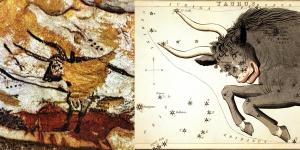Blog
Writing on the Wall
30 March 2015
 Prof. Saxx/Wikipedia
Prof. Saxx/WikipediaJust how old is astronomy? We aren’t really sure, but we do know astronomy pre-dates history. By the 4th century BC, for example, the Greeks had already developed a model of the solar system that described the motions of the planets reasonably well. A thousand years earlier, the Egyptians had already mapped the heavens in detail. Around the same time, astronomers in pre-historic Germany had developed a portable astronomical tool known as the Nebra sky disk. The earliest known observatory capable of such measurements is the Goseck circle, dating to 4500 BCE. This consisted of a series of concentric ditches with wooden posts to determine positions. Less ancient (2400 BCE) but more famous is Stonehenge, which used stones and wooden posts to determine astronomical positions. It’s clear that we’ve had sophisticated astronomy for thousands of years.
The deeper you go into history, the more difficult it is to verify astronomical efforts. We look at astronomical patterns with a modern eye, and it’s tempting to see marks on a bone or paint on a wall that seems to fit a known astronomical pattern. It’s also a field that is rife with amateur archeologists seeking to prove wild theories such as the existence of ancient aliens or that Egyptian civilization is much older than we think.
Not being an expert in the field, I’m reluctant to comment too much on the earliest history of astronomy, but it seems reasonable given the sophistication of early astronomy that humans have been astronomers for thousands of years by that time. There are some interesting clues in support of that idea, such as the paintings of the Lascaux Caves. The detail of these images clearly show that their creators were keen observers, and there are patterns that appear (at least to modern eyes) to resemble star maps. In the image above, for example, you can see a painting from the cave that shows an auroch, which is the ancestor of domestic cattle. To the right of the animal is a cluster of dots that is similar to the Pleiades, and to the left is a line of dots similar to the belt of Orion. There’s debate over whether this kind of imagery really is a star map of the region we now call Taurus, but if it is that would put the origins of astronomy at least as far back as 17,000 years.
Even if we are reading too much into the cave paintings, the observational skill shown in them was the same skill that would allow us to become true astronomers.